What Happened to Soap Operas? A Statistical Analysis
The dramatic rise and fall of the soap opera.
Intro: “TV’s Richest Market”
Before Kate and William’s royal wedding, there was Luke and Laura’s marriage on General Hospital. In 1981, the long-awaited union of two fictional characters drew 30 million viewers—still the most-watched episode in daytime television history, exceeding that week’s Monday Night Football audience by 10 million households. The event was further elevated by a surprise cameo from legendary movie star Elizabeth Taylor, who personally requested an appearance in the wedding extravaganza.
In 1996, TV Guide ranked Luke and Laura’s wedding as #35 on its list of the “100 Most Memorable Moments in TV History”—cementing the event as a cultural high point for the daytime soap opera.
In the 1970s and 1980s, watching television between noon and 3 p.m. meant watching a soap opera. At their peak, close to 20 soap series ran concurrently across four television networks, dominating daytime programming. In 1976, Time magazine described the daytime soap as “TV’s richest market” due to the loyalty of its fanbase and the advertising revenue generated from its captive audience.
Today, the soap opera teeters on the brink of extinction, with three series still airing on network television and a fourth relegated to Peacock (a totally real streaming service best known for Love Island USA and The Office, and that’s it). Watching TV at noon on a Tuesday is no longer synonymous with Days of Our Lives or The Young and the Restless—and if you’ve never heard of these series, then you’ve further proved my point.
So today, we’ll examine the decline of the soap opera and identify the programming that took its place.
What Happened to the Soap Opera?
TV soap operas got their start in the most unlikely of places: the radio. Debuting in 1930, the first radio soap series told the story of three sorority sisters—Clara, Lu, and Em—as they navigated the ups and downs of daily life. These operatic tales were frequently sponsored by household brands—especially soap makers like Procter & Gamble—which led to the now-ubiquitous “soap opera” moniker.
Since its transition to network television, the soap opera has remained remarkably consistent for more than 70 years, even as other TV genres evolved with the advent of cable and streaming. Along the way, countless shows have borrowed (and reinvented) storytelling tropes pioneered by the soap format. Today, the defining criteria for what constitutes a soap opera have grown blurrier, though critics generally agree on a few core traits:
Serialized storytelling: In the 1960s and 1970s, most prime-time shows were episodic—self-contained stories that reset each week. Detective dramas tackled a new case every episode, while sitcoms delivered fresh hijinks with little lasting consequence. Soap operas, by contrast, were known for continuity, building long-running storylines and ending episodes with melodramatic cliffhangers. Today, all television is serialized, except for Young Sheldon.
High episode volume: Many soaps aired five days a week, with this demanding pace inevitably breeding some downstream wackiness: low-quality production value, ludicrous plotting, and a general sense of complacency from those tasked with producing ~220 episodes of television each year. Compare this output to Severance, which required three years to release its ten-episode second season.
Aired during the day: This is not an absolute constraint. That said, if the year is 1979 and you’re consuming television content at 1 p.m., then you’re most certainly watching a soap opera.
Overriding focus on dialogue and exposition: Other soap opera hallmarks include slower pacing, recaps at the beginning of each episode, clunky exposition dumps woven into character dialogue, and staging that prioritizes dialogue over action.
The soap opera’s popularity declined as other genres adopted its signature storytelling techniques and as the television landscape became increasingly crowded with new content. Over the next four decades, soaps were steadily overtaken by a wave of emerging television formats, including reality TV, cooking competitions, game shows, true crime, Is It Cake?, CSI: Boise, and an endless scroll of random streaming content. Sitcoms and soaps—once pillars of network television—were rendered obsolete by this onslaught of new programming.
To grasp the scale of this decline, consider the viewership ratings for nine long-running American soap operas. At their peak, each series reached 10-15% of U.S. TV-watching households—at a time when only four television networks existed.
So what happened to soap opera viewership? The most compelling explanation centers on a failed handoff between generations. When we examine modern soap viewership by age, we see a sharp drop-off between the 50+ cohort and those aged 35 to 49. Today, more men over 50 watch The Young and the Restless than women between the ages of 18 and 49—a statistic that would’ve been unthinkable in the 1970s.
Throughout my research, media pundits offered the same tired explanation for this decline, often with near-identical phrasing: younger women simply “never learned” to watch soap operas from their mothers. The framing here is rather strange, as if soap fandom was some divine right passed from mother to daughter like a family heirloom (or curse). Regardless of how this idea is expressed, the demographical reality holds: soap opera consumption was traditionally dominated by female viewers, and that audience has since moved on. So what replaced the soap opera among its core demographic?
In 2022, Nielsen published annual viewership data on the preferred streaming titles of women ages 18-34. Topping the list were medical dramas, crime procedurals, and reality TV.
One show in particular caught my attention: Grey’s Anatomy, a long-running prime-time series that premiered during George W. Bush’s presidency. This series is not-not a soap opera, though it’s rarely grouped alongside traditional daytime staples like General Hospital or Days of Our Lives.
To understand the origins of Grey’s Anatomy—and the programming that ultimately supplanted the soap opera—we must first backtrack to two transformative TV events from the early 1990s:
The O.J. Simpson Trial: I assure you, this is not a bit. O.J. Simpson’s murder trial aired in place of traditional daytime programming while simultaneously proving the commercial viability of entirely new genres (i.e., true crime, reality TV, and shows with judges). Audiences would gladly accept and obsess over real-life crime, reality content, and the messiness of other humans—formats that required significantly less effort than a daytime soap opera.
Twin Peaks’ Premiere: Twin Peaks borrowed the best elements of the soap opera—serialized storytelling, cliffhangers, melodramatic twists—and transformed them into something entirely new. At its core was a long-running mystery: who killed Laura Palmer? The series set the template for what would later become prestige television, revealing the medium’s capacity for depth and narrative sophistication. The entire affair is made even stranger when you consider Twin Peaks’ co-creator was David Lynch, the lovable avant-garde weirdo behind films like Blue Velvet, Mulholland Drive, and Eraserhead (Google “baby from Eraserhead” if you want to grasp just how bizarre it is that Lynch ever made a network TV show).
Twin Peaks is an early example of a subgenre that the internet has since taxonomized as “Soap Opera - Drama”—a category that stands apart from the traditional soap opera. To gain a clearer understanding of this programming subcategory, I pulled the most popular shows associated with this IMDb tag. At the very top sits Grey’s Anatomy—the patron saint of this emergent subgenre.
These shows retain several hallmarks of the soap format, but without the burdens of a daily release schedule, midday time slot, or limited budget. Over time, this modernized soap descendant has gained traction, with an increasing number of English-language series receiving the “Soap Opera - Drama” tag on IMDb.
If this loosely defined internet label reads as arbitrary—well, that’s kind of the point. In today’s TV landscape, the term “soap opera hybrid” could describe half of prestige television. If Grey’s Anatomy qualifies, does that mean The West Wing and The Pitt also deserve the same label? And if Twin Peaks has soap-like traits, what about True Detective or Mare of Easttown?
So what sets the traditional soap opera apart? Legacy soaps like Days of Our Lives and The Young and the Restless are now defined by a handful of increasingly outdated traits: daily episodes, midday time slots, and multi-camera setups—all relics from a bygone era of television.
Final Thoughts: “Isn’t That All TV?”
Many things have not aged well about Friends, including:
Endless skyline shots featuring the Twin Towers
Some of the humor, as is the case for any sitcom from the 1990s
The unrealistic spaciousness of a two-bedroom apartment in Manhattan
But perhaps the most anachronistic detail of all is Joey’s job as a soap opera star. When my child inevitably watches this series in the year 2040, someone’s profession being “soap opera” will be like Ken’s job being “beach” in the Barbie movie.
Sometimes I imagine explaining outdated pop culture phenomena to this future child, covering everything from TiVo to Gangnam Style to Young Sheldon to ‘Friends as a time capsule of 1990s America.’ Upon watching Friends for the first time, my child will inevitably ask, “What were these soap opera shows Joey starred in?”
To which I’ll explain: “They were long-running TV stories that were super talk-y, with melodramatic cliffhangers so you would watch the next installment.”
My kid, being wicked smart and kinda sassy, will respond, “Isn’t that all television?”
“Sort of,” I’ll say. “But these aired every day at 1 p.m.”
“Every day?! At a set time?! Who watched these things?”
And I’ll clarify: “Broadly speaking, stay-at-home moms and older folks, but eventually everybody moved on to other forms of content.”
As this deeply instructive conversation draws to a close, my child will smile and say, “You’re a great dad—with extremely impressive pop culture knowledge.” Then we’ll sit down and watch season 35 of Grey’s Anatomy, in which a hologram of Meredith Grey saves her 200th patient from certain death. Soap operas will be gone, but their cultural legacy will persist (much like Meredith Grey).
Like any commercial art form—be it music or movies—television evolves through a mix of creative mutation and Darwinian selection. Storytelling conventions enter the (proverbial) gene pool and are validated by viewership, while others are phased out when they lose their commercial or cultural relevance.
In its heyday, the daytime soap was one of television’s most innovative formats, pioneering several tropes that would later define prestige TV. But in the end, this format was a victim of its own inflexibility. In the year 2040, the best parts of the soap opera will live on in every TV show, while the worst aspects of this phenomenon will be lost to time—relics of a pre-O.J., pre-David Lynch era of television.
Struggling With a Data Problem? Stat Significant Can Help!
Having trouble extracting insights from your data? Need assistance on a data or research project? Well, you’re in luck because Stat Significant offers data consulting services and can help with:
Insights: Unlock actionable insights from your data with customized analyses that drive strategic growth and help you make informed decisions.
Dashboard-Building: Transform your data into clear, compelling dashboards that deliver real-time insights.
Data Architecture: Make your existing data usable through extraction, cleaning, transformation, and the creation of data pipelines.
Want to chat? Drop me an email at daniel@statsignificant.com, connect with me on LinkedIn, reply to this email, or book a free data consultation at the link below.
Want to chat about data and statistics? Have an interesting data project? Looking to produce data-centric editorial content? Email daniel@statsignificant.com




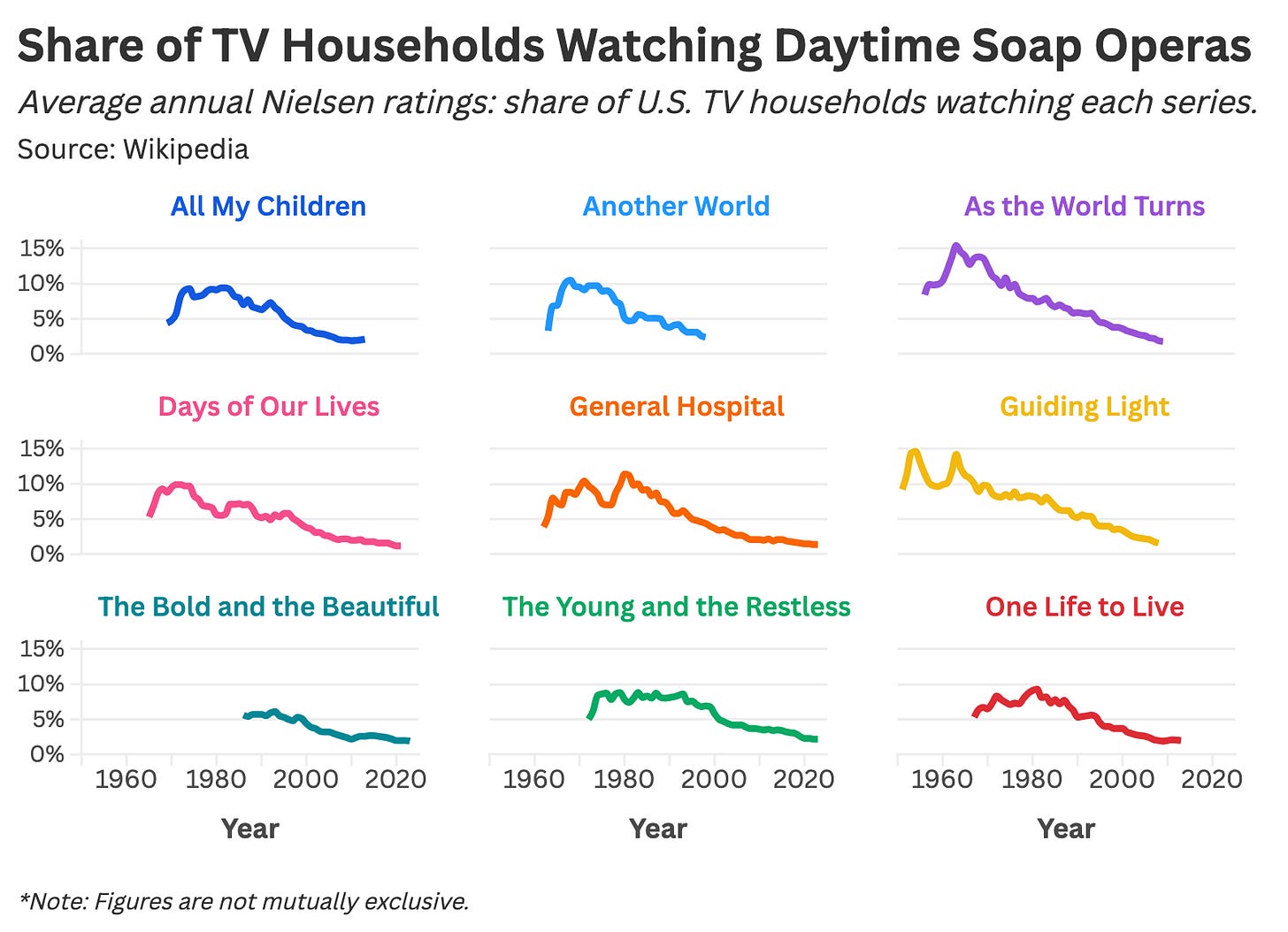
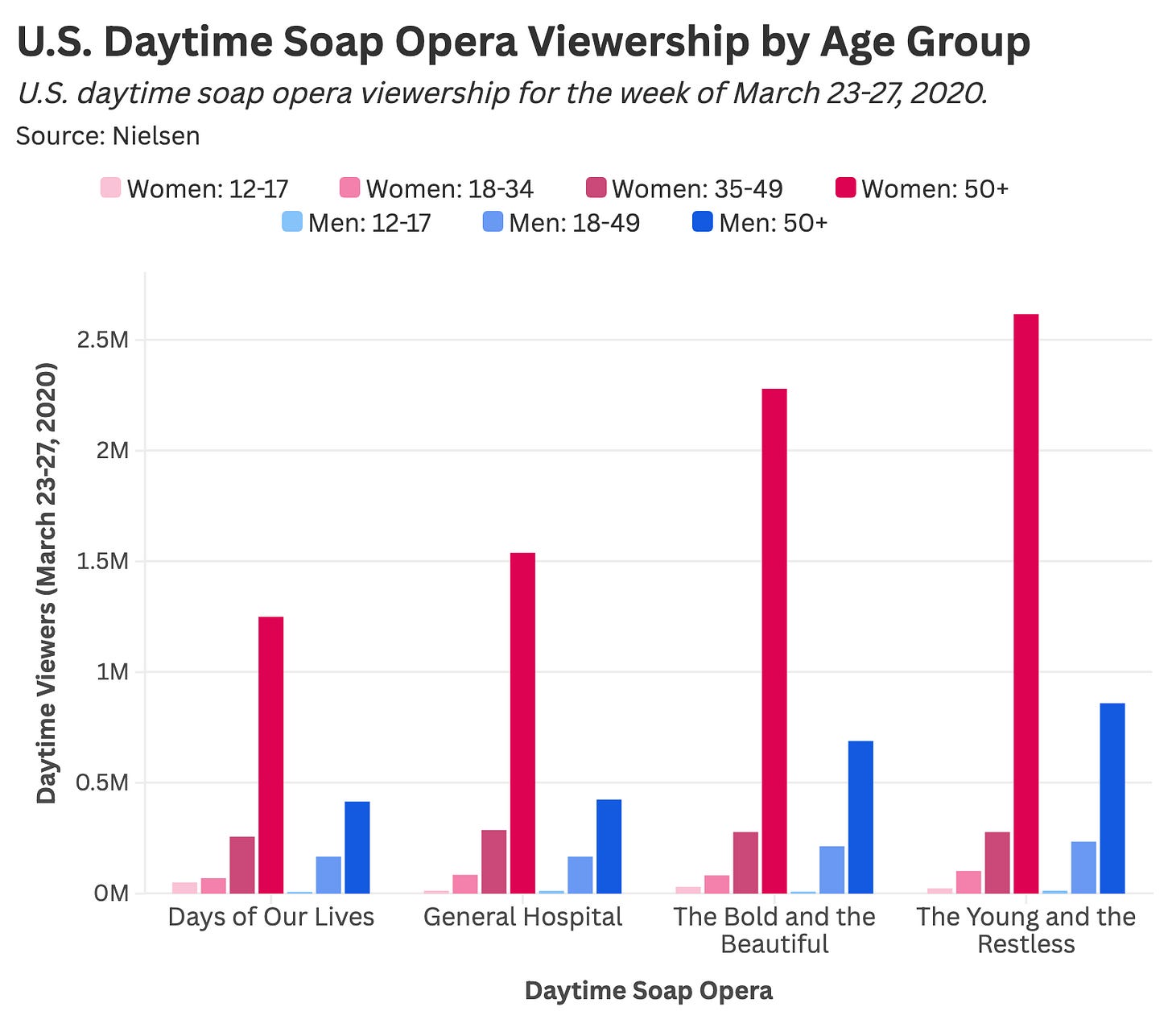
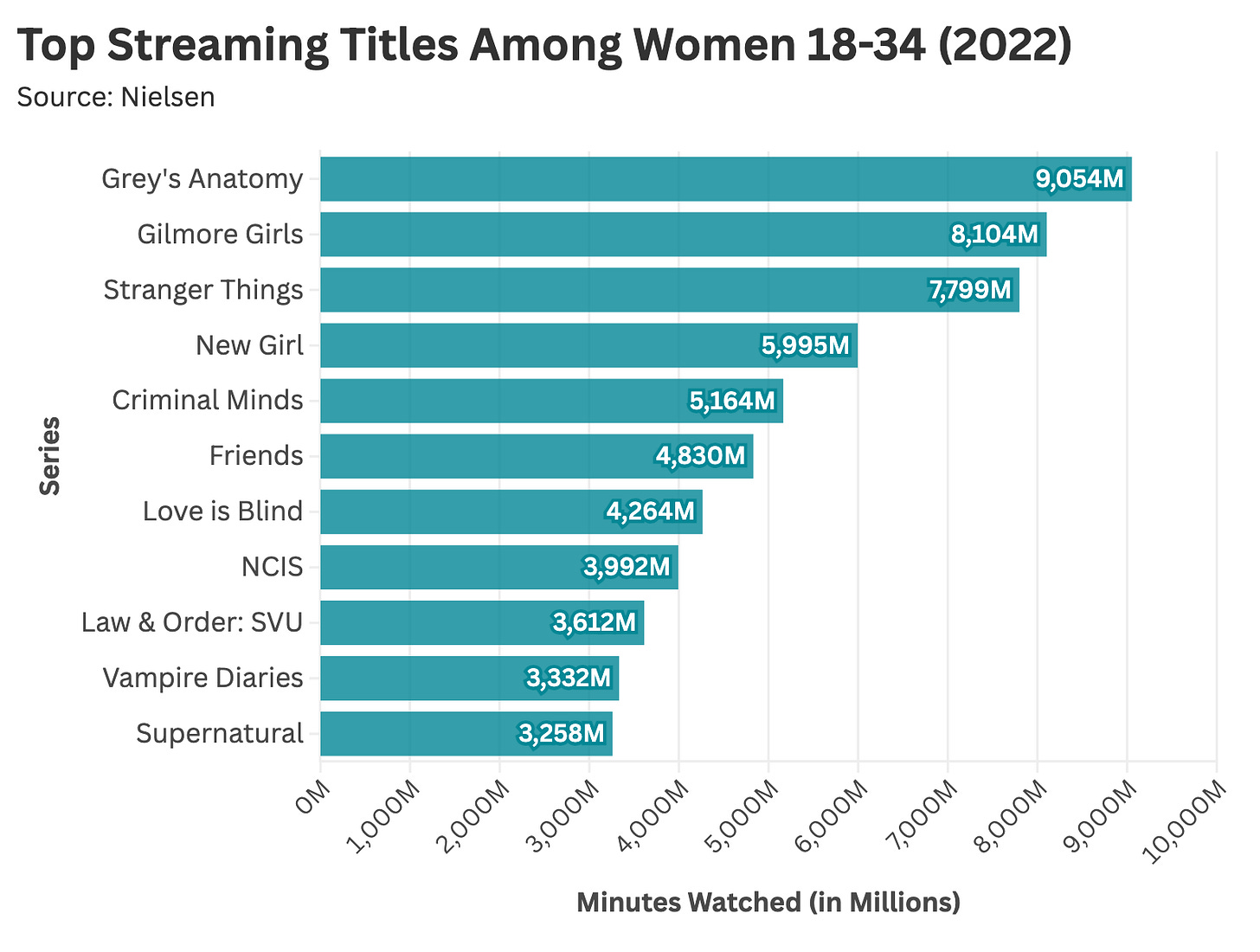
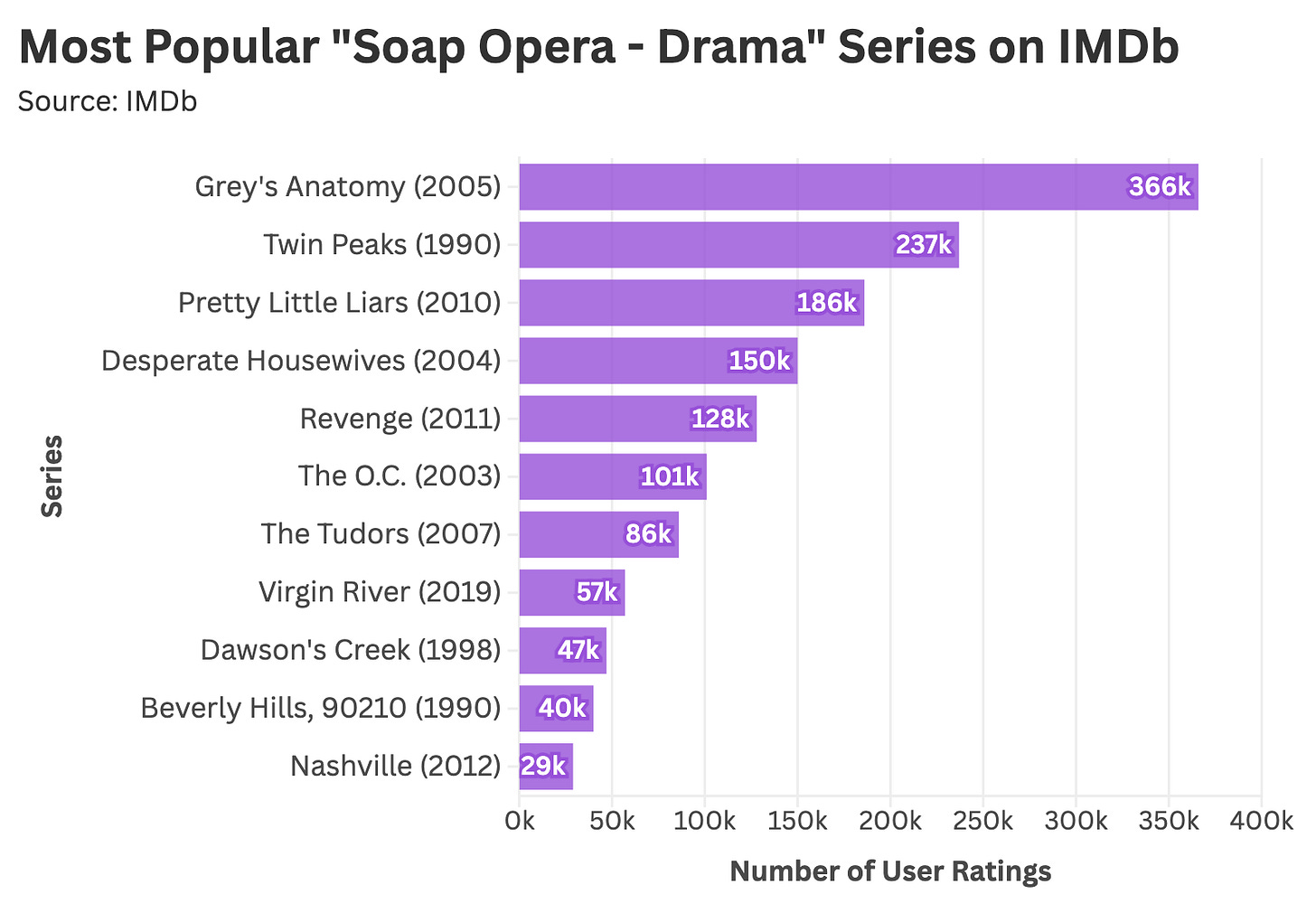
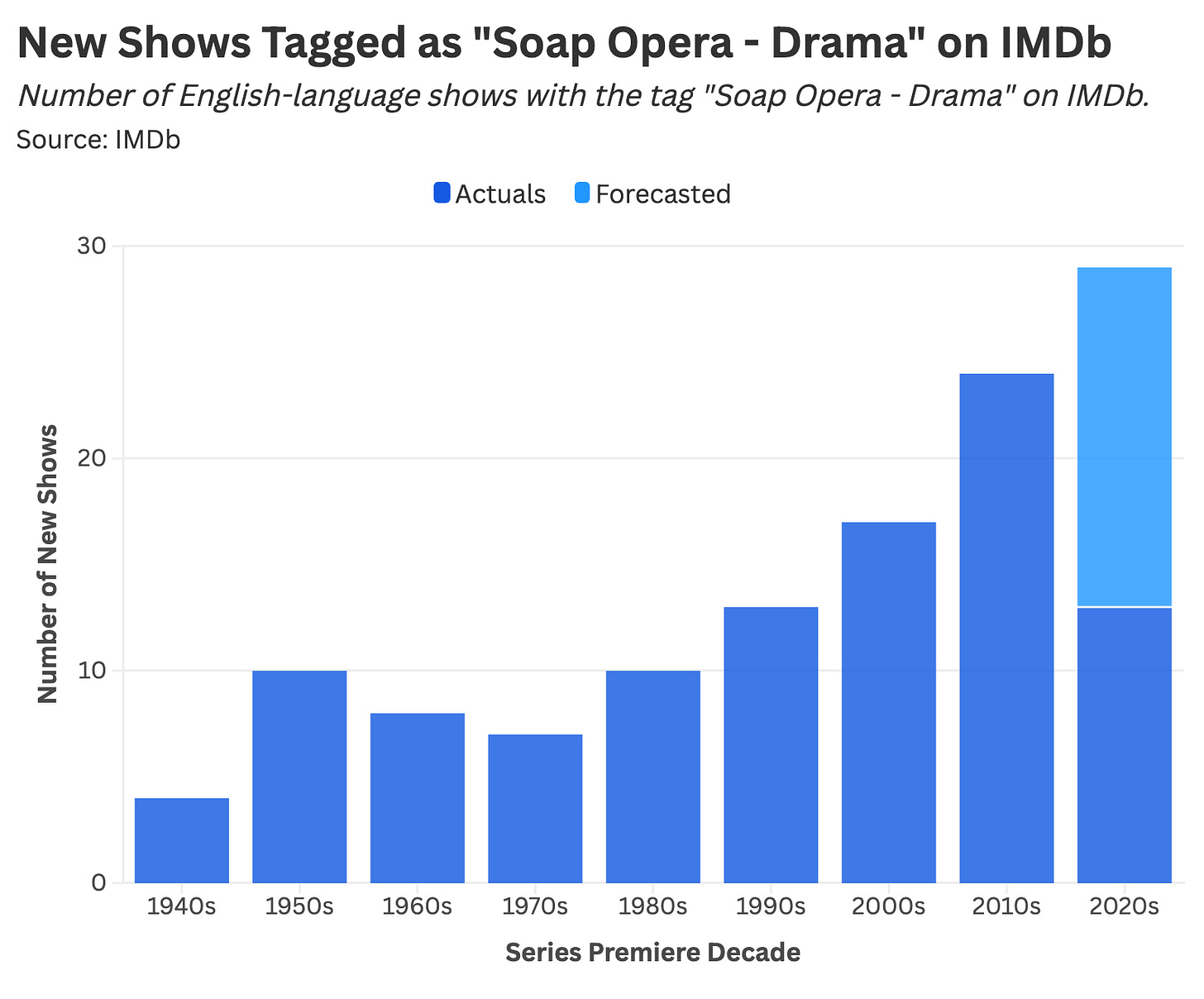
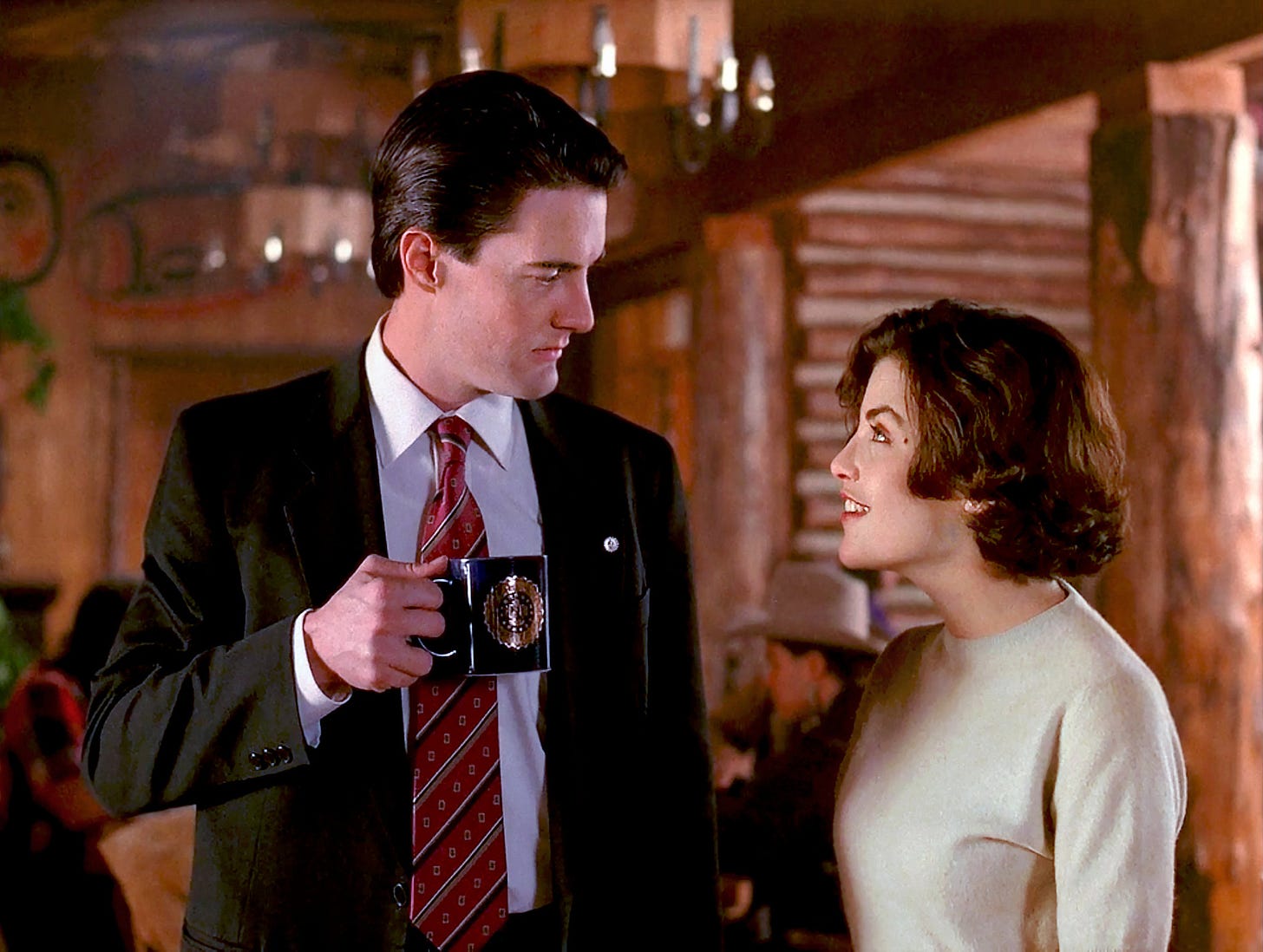

i'd be interested to see how the stats compare in UK, AU and NZ - from watching a lot of taskmaster, ongoing soaps like coronation street, eastenders, neighbours, and shortland street still get referenced as universal touchstones that need no explanation
you didnt mention anything about Bravo genre of “Housewives” shows. Aren’t those the new soap operas?